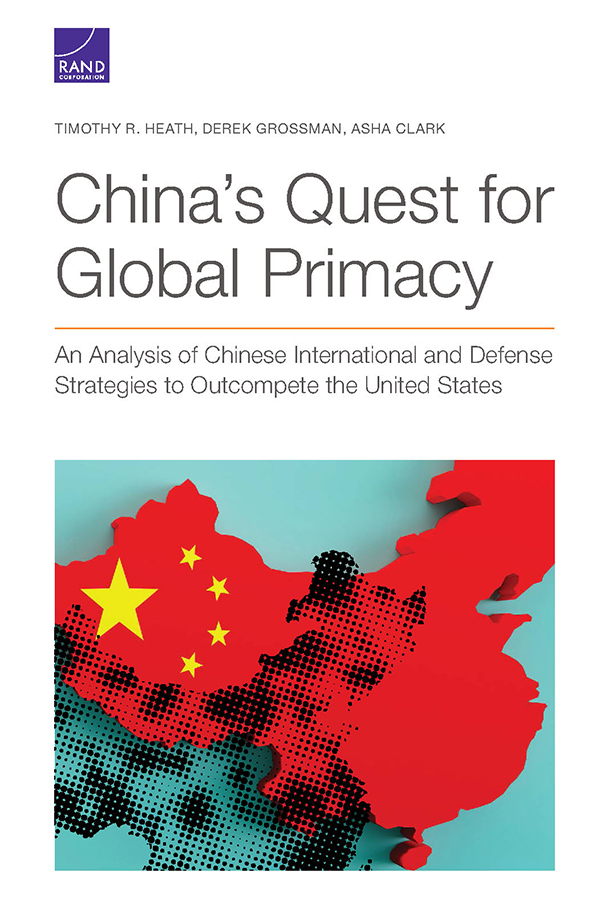Chinese International and Defense Strategies to Outcompete the US.
Read Also:- China’s Quest for Global Primacy (Part 2)
RAND Corpn completed a research in Aug 2020, sponsored by the Office of the US Secretary of Defense, exploring possible international and defense strategies that China might employ to outcompete the United States and achieve a position of international primacy. The posited strategies, although created by the authors (TIMOTHY R. HEATH, DEREK GROSSMAN, ASHA CLARK), are framed by findings regarding Chinese political processes, concepts, policies, and national goals.
The purpose of the analysis was threefold: to support U.S. planning and decision-making, to educate readers about China’s strategy and policymaking process, and to spur discussion about the stakes and nature of the competition.
Here is an Executive Summary.
U.S.-China relations have entered a new phase characterized by sharpening competition. As the gap in comprehensive national power has narrowed, Beijing’s pursuit of national revitalization has coincided with a deepening of tensions with the United States over long-standing disputes regarding Taiwan, the South China Sea, and the U.S. military presence in Asia. In addition, new points of contention, including China’s crackdown on Hong Kong and Xinjiang, and escalating feuds over trade and technology have pushed bilateral ties to their worst condition in decades. Even shared threats, such as the coronavirus disease 2019 (COVID-19) pandemic, have proved to be occasions for the two sides to trade accusations and compete for influence. The unsettled relationship between the world’s two largest economies has unnerved the international community. More ominously, observers anxiously warn of the risk that the intensifying rivalry could follow a well-established pattern of conflict between rising and status quo great powers.
Chinese authorities frankly acknowledge the inevitability of competition but reject the notion that conflict is inevitable. This perspective suggests that Beijing recognizes the importance of having a
balanced and nuanced competitive strategy that avoids disastrous missteps. No official Chinese document that outlines a strategy for managing competition with the United States is known to exist. If it does exist, its contents have not been made available to the public, nor should we expect Beijing to publish them, given the sensitivity of the topic. Yet the questions that any such strategy might have addressed remain imperative. How should we understand Beijing’s approach to the competition with the United States? What might be Beijing’s desired end state for the bilateral relationship? What does success in the competition mean to China? What foreign policy and defense-related objectives regarding the United States might China have? What might Beijing view as vulnerabilities in its approach? This research aims to shed light on such questions.
Focusing on the foreign policy and defense dimensions of the competition, the authors propose with this research to make three contributions.
First and foremost, we intend the report to serve as a planning tool by positing international and defense strategies that could allow China to outcompete the United States. Such a tool could facilitate U.S. government efforts to formulate its own strategies and policies to protect U.S. interests. Second, the analysis is meant to educate readers on how the Chinese view the competition with the United States.
In hopes of more closely approximating how Beijing might actually conceptualize the competition, the authors aim to reflect a Chinese perspective as much as possible. Third, we seek to raise awareness and encourage greater public debate about the stakes of a U.S.-China competition that has expanded in scope and complexity.
Because the authors seek to present competitive strategies from a Chinese perspective, we rely primarily on unclassified Chinese documents. U.S.-China relations remains a topic of intense interest among Chinese officials and analysts. An enormous volume of official documents, commentaries, and scholarly writings has examined the relationship from many angles. This literature provides an important resource for discerning key themes and ideas in Chinese policy and debates. As much as possible, the team from the RAND Corporation has sought to adhere to the same authoritative sources and intellectual materials that Chinese officials would draw from to develop any foreign policy or defense strategy document. In addition to these documents, the authors also examined Western reporting and academic scholarship on issues related to the U.S.-China competition.
As presented by the authors, China’s international strategy aims to establish the country’s primacy in the Asia-Pacific region. It also seeks to establish Chinese leadership of the international order. However, China’s contest for global leadership need not wait until after it has secured regional primacy. The strategy proposes that China pursue both at the same time, underpinned by the notion that progress toward either regional- or global-level objectives could enable progress toward the other. If successful, China will have surpassed the United States to become the paramount regional power and the leading global power. However, China’s international leadership would bear little resemblance to the forms exercised by previous global leaders such as the United States and Great Britain. Exercising a partial global hegemony centered principally on Eurasia, the Middle East, and Africa, Chinese international leadership would be characterized by a reliance on finance, diplomatic engagement, and security assistance to exercise influence while maintaining a modest overseas military presence.
As posited by the authors, China’s standard for successful competition with the United States thus entails the following conditions by midcentury:
(1) War with the United States is avoided, although this does not exclude the possibility of militarized crises or conflicts of a limited scope (e.g., proxy wars);
(2) The United States respects China’s authority as the global leader, even as the United States remains a powerful, but clearly inferior, nation;
(3) The United States largely refrains from harming Chinese interests;
(4) China has established primacy across much of Eurasia, the Middle East, and Africa, principally through patronage of client states;
(5) U.S. primacy has been reduced to the Americas, although it may still maintain a military, economic, and diplomatic presence worldwide;
(6) The United States and China manage their differences according to norms upheld by China; and
(7) The two cooperate on shared concerns on terms defined largely by the Chinese.
The consequences of Chinese success in strategic competition could be severe for the United States. Sitting astride the heart of the global economy, Beijing would be well situated to privilege its needs and those of its clients over those of the United States and its allies.
This situation would likely entail a deleterious downgrading in the prospects for the United States. Poorly positioned to unseat China or easily reverse its own flagging fortunes, the United States could face dwindling economic prospects, international marginalization, and a diminishing ability to shape global affairs.
The international strategy presented seeks to achieve this end state through peaceful methods, although it does not rule out the possibilities of militarized crises or even conflicts of a limited scope, such as proxy wars. The core of the proposed international strategy is a reliance on China’s economic prowess and diplomatic maneuver to put Beijing into a position of advantage from which it cannot be dislodged by the United States. Regarding major powers, the posited strategy seeks to ensure the United States and Europe remain divided in their approach to China while Russia cooperates closely as a junior partner.
The Asia-Pacific region remains a priority area, and the strategy envisions Beijing weakening U.S. alliances, expanding its own network of client states, renovating and leading regional multilateral institutions, and deepening the region’s integration into a Chinese-led economic, political, and technological order. Beijing regards the developing world as a key constituency for its international leadership, and the strategy posited here aims to build a network of client states across Eurasia, Africa, the Middle East, and Latin America. Chinese success in establishing itself as a principal arbiter in Middle Eastern affairs, as the main sponsor of Africa’s economic development, and as a major partner in Latin America could result in a severe weakening in the strategic position of the United States as a global leader and undercut its position in the Indo-Pacific theater as well. In the multilateral domain, the strategy envisions a broad effort to shape rules, norms, and agendas to favor the interests of China and its clients at the expense of the United States.
Beijing’s global governance strategy similarly aims to bolster China’s influence and delegitimize that of the United States in appropriate venues. For each section of this chapter, the authors have proposed objectives for the 2035 time frame that could guide the development of relevant criteria against which China’s progress could be assessed. An appendix offers some sample subobjectives that could be used to evaluate Chinese progress toward relevant objectives.
Defense strategy plays an important but supplementary role to the proposed Chinese international strategy. A complementary defense strategy would aim to constrain Washington’s ability to forestall or prevent its own eclipse by building a superior Chinese military that renders the risks of military conflict intolerably high in the Asia-Pacific theater. The defense strategy also aims to deter the United States from challenging China in any contingency along its periphery and provide support to gray-zone activities that incrementally change the status quo at the expense of the United States and its allies. A major military responsibility would be to support diplomatic efforts to shape a favorable international environment by building strong security ties with client states and discrediting or weakening the appeal of the United States as an alternative. The defense strategy also raises the possibility of engaging in proxy or other more-limited conflicts to protect the interests of client states and demonstrate the superiority of Chinese power. To address concerns about the risks of miscalculation and escalation in any incident involving the United States, however, the defense strategy emphasizes the importance of preventing conflict, managing crisis, and strict control of military forces by civilian authorities in any contingency. At the same time, the strategy leaves open the possibility for cooperation with the U.S. military on shared security threats. The strategies depicted in this research should not be construed as predictions of how the competition may evolve. Whether China can prevail is hardly predetermined, and the United States continues to enjoy many strategic advantages. The outlook is further complicated by the sheer variety and types of factors—some of which may not be well understood today—that could affect the trajectory of the competition.
Read Also:- China’s Quest for Global Primacy (Part 2)


















